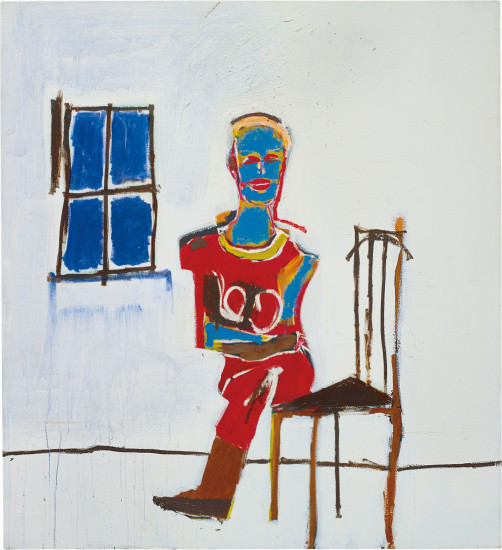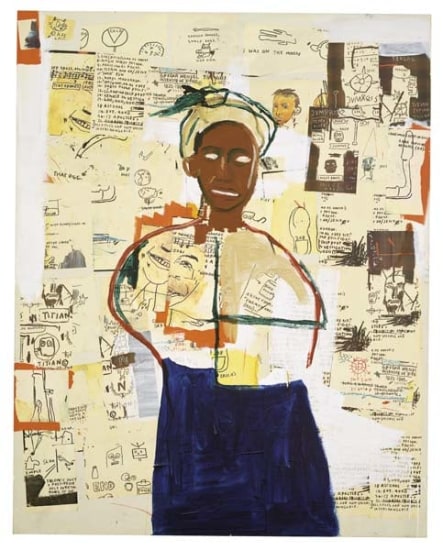Jean-Michel-Basquiat Untitled 1982 pastel, oilstick, coloured crayon and charcoal on paper 76.2 x 109.2 cm (30 x 43 in) Signed and dated 'Jean Michel Basquiat/1982' lower right. This work is accompanied by a certificate of authenticity issued by the Authentication Committee of the Estate of Jean-Michel-Basquiat.
Provenance Annina Nosei Gallery, New York Christie's New York, 'Contemporary Art', 2 November 1984, lot 229 Galerie Daniel Templon, Paris Private Collection Catalogue Essay The present lot, Untitled, was executed in 1982 with pastel, oilstick, coloured crayon and charcoal on paper. Art historically, works on paper have acted as studies or subsidiary works alongside an artist’s main output. It is arguable that Basquiat was more comfortable working on paper than on canvas. His favourite medium, pastel and oilstick, flowed uninhibitedly on the smooth surface of paper and suited his unprompted and expressionistic style. The same imagery and text occurred in both forms of expression throughout Basquiat’s œuvre - the drawings nourished the paintings, and the paintings evolved into drawings in a circular and replenishing cycle. This is apparent when comparing Untitled with Profit I, also executed in 1982. Untitled has an assured richness and quality of mark making that can rival the best of Basquiat’s works on canvas. "Drawing was an essential element in the art of Jean-Michel-Basquiat. The artist made no hierarchical distinction between drawing and painting, and in fact, his paintings and drawings are often indistinguishable, and only differ in their paper or canvas support. Basquiat drew on paper, canvas, and wood with graphite, oilstick, watercolor, and acrylic. He did it with a confidence and sophisticated hand, rapidly and spontaneously, and corrected or revised instantaneously and visibly. Drawing was a constant activity for the artist, and during his relatively short career he produced probably a few thousand works on paper." (R. Marshall The Drawings of Jean-Michel-Basquiat, p. 30) Untitled focuses on the human face and upper torso. The human figure is central to Basquiat’s works, especially in the early drawings of 1981–82, made while he was working out of the basement of Annina Nosie’s gallery on Prince Street, New York. The right side of the canvas is dominated by a human face painted in an archetypally bold and aggressive style. The head is set against a golden backdrop and is adorned with what appears to be a Crown of Thorns, investing the figure with the symbolism of the passion of Christ and further recalling early Italian Renaissance depictions of Christ such as by Giotto. Whereas in Basquiat’s later works, in which his subjects represent African-American musicians, athletes and political figures such as Robert Johnson Charlie Parker, Joe Louis and Malcolm X, in Untitled the figure remains anonymous but, importantly, introduces to the viewer a black protagonist. Basquiat’s depiction of African- American culture is usually treated with a stream-of-consciousness technique by which the artist constructs a social commentary on racial inequality and integration with autobiographical subject matter. Coming from a poor background – Basquiat’s father was Haitian and his mother a new york puerto rican – Basquiat found unprecedented fame and wealth in a very short amount of time, only to succumb to the pressures and prejudices of the white elitist new york art world of the 1980s, resulting in his unexpected death at the age of twenty seven. In the present lot, the left half of the picture is dominated by the figure’s raised arm, drawn, like the face, with a raw intensity that recalls the naïve figures which populated the artist’s early street art in downtown New York. The disproportionally elongated arm and hand perhaps allude to a crucifixion or an action of surrender or alarm. Equally, the gesture could be seen as a powerful sign of protest and revolution. The anatomically accurate hand is surrounded by a thick black outline and in areas is filled with black oilstick, representing a glove. This immediately recalls the Black Power salute that came to represent the African-American civil rights movement of the 1960s, the apogee of which was the defiant salute of the African- American runners Tommie Smith and John Carlos while
Jean-Michel-Basquiat Untitled 1982 pastel, oilstick, coloured crayon and charcoal on paper 76.2 x 109.2 cm (30 x 43 in) Signed and dated 'Jean Michel Basquiat/1982' lower right. This work is accompanied by a certificate of authenticity issued by the Authentication Committee of the Estate of Jean-Michel-Basquiat.
Provenance Annina Nosei Gallery, New York Christie's New York, 'Contemporary Art', 2 November 1984, lot 229 Galerie Daniel Templon, Paris Private Collection Catalogue Essay The present lot, Untitled, was executed in 1982 with pastel, oilstick, coloured crayon and charcoal on paper. Art historically, works on paper have acted as studies or subsidiary works alongside an artist’s main output. It is arguable that Basquiat was more comfortable working on paper than on canvas. His favourite medium, pastel and oilstick, flowed uninhibitedly on the smooth surface of paper and suited his unprompted and expressionistic style. The same imagery and text occurred in both forms of expression throughout Basquiat’s œuvre - the drawings nourished the paintings, and the paintings evolved into drawings in a circular and replenishing cycle. This is apparent when comparing Untitled with Profit I, also executed in 1982. Untitled has an assured richness and quality of mark making that can rival the best of Basquiat’s works on canvas. "Drawing was an essential element in the art of Jean-Michel-Basquiat. The artist made no hierarchical distinction between drawing and painting, and in fact, his paintings and drawings are often indistinguishable, and only differ in their paper or canvas support. Basquiat drew on paper, canvas, and wood with graphite, oilstick, watercolor, and acrylic. He did it with a confidence and sophisticated hand, rapidly and spontaneously, and corrected or revised instantaneously and visibly. Drawing was a constant activity for the artist, and during his relatively short career he produced probably a few thousand works on paper." (R. Marshall The Drawings of Jean-Michel-Basquiat, p. 30) Untitled focuses on the human face and upper torso. The human figure is central to Basquiat’s works, especially in the early drawings of 1981–82, made while he was working out of the basement of Annina Nosie’s gallery on Prince Street, New York. The right side of the canvas is dominated by a human face painted in an archetypally bold and aggressive style. The head is set against a golden backdrop and is adorned with what appears to be a Crown of Thorns, investing the figure with the symbolism of the passion of Christ and further recalling early Italian Renaissance depictions of Christ such as by Giotto. Whereas in Basquiat’s later works, in which his subjects represent African-American musicians, athletes and political figures such as Robert Johnson Charlie Parker, Joe Louis and Malcolm X, in Untitled the figure remains anonymous but, importantly, introduces to the viewer a black protagonist. Basquiat’s depiction of African- American culture is usually treated with a stream-of-consciousness technique by which the artist constructs a social commentary on racial inequality and integration with autobiographical subject matter. Coming from a poor background – Basquiat’s father was Haitian and his mother a new york puerto rican – Basquiat found unprecedented fame and wealth in a very short amount of time, only to succumb to the pressures and prejudices of the white elitist new york art world of the 1980s, resulting in his unexpected death at the age of twenty seven. In the present lot, the left half of the picture is dominated by the figure’s raised arm, drawn, like the face, with a raw intensity that recalls the naïve figures which populated the artist’s early street art in downtown New York. The disproportionally elongated arm and hand perhaps allude to a crucifixion or an action of surrender or alarm. Equally, the gesture could be seen as a powerful sign of protest and revolution. The anatomically accurate hand is surrounded by a thick black outline and in areas is filled with black oilstick, representing a glove. This immediately recalls the Black Power salute that came to represent the African-American civil rights movement of the 1960s, the apogee of which was the defiant salute of the African- American runners Tommie Smith and John Carlos while

.jpg)









Try LotSearch and its premium features for 7 days - without any costs!
Be notified automatically about new items in upcoming auctions.
Create an alert